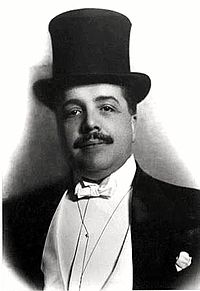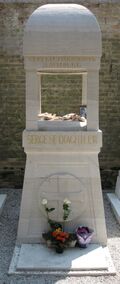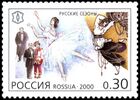سرگي دياگليف
سرگي دياگلييف | |
|---|---|
Серге́й Дя́гилев | |
 | |
| وُلِدَ | Sergei Pavlovich Diaghilev 31 مارس 1872 |
| توفي | 19 أغسطس 1929 (aged 57) |
| المثوى | أيزولا دي سان ميشله، قرب البندقية |
| القومية | روسي |
| المهنة | ناقد فني, راعي ومتعهد حفلات الباليه |
| عـُرِف بـ | مؤسس فرقة الباليه الروسي |
| الأقارب | ديمتري فيلسوفوف (ابن عم) |
| التوقيع | |
سرگي پاڤلوڤتش دياگليف ( Sergei Pavlovich Diaghilev ؛ /diˈæɡ[invalid input: 'ɨ']lɛf/; روسية: Серге́й Па́влович Дя́гилев, Sergei Pavlovich Dyagilev, تـُنطق [sʲɪˈrɡʲej ˈpavləvʲɪtɕ ˈdʲæɡʲɪlʲɪf]؛ و. 31 مارس [ن.ق. 19 مارس] 1872 – ت. 19 أغسطس 1929) عادة يشار إليه خارج روسيا باسم سيرج، هو ناقد فني روسي وراعي باليه ومتعهد الحفلات للباليه ومؤسس فرقة الباليه الروسي، التي عمل فيها الكثير من الراقصين المشاهير ومصممي الرقصات.
يمكن تقسيم سيرة دياگلييف إلى فترتين: في سانت پطرسبورگ (1898–1906) وفي المهجر (1906-1929).[1]
الباليه الروسي
الكونشرتوات التاريخية الروسية
The success of the 1906 exhibition inspired Diaghilev to present Russian music to the world’s culture capital. In 1907, he organised ‘Concerts historiques russes’ with famous composers like Nikolai Rimsky-Korsakov, Sergei Rachmaninoff, Alexander Glazunov, Feodor Chaliapin, and Félia Litvinne. The tour was supported and sponsored by Diaghilev’s royal patrons Grand Duke Andrei Vladimirovich of Russia and Duchess Marie of Mecklenburg-Schwerin. In the spring of 1908, Diaghilev mounted a production of Mussorgsky's Boris Godunov, starring Feodor Chaliapin, at the Paris Opéra. Boris Anisfeld created the sets, designed by Bakst and Benois. To maximize authenticity, one of the artists Ivan Bilibin even travelled to Arkhangelsk Oblast to purchase the costumes.[2] The tour became a sensation and the success was overwhelming, however, financially, it was unprofitable and ended with a loss of 85,000 francs.[3]
الباليه الروسي
By 1909, Diaghilev was at odds with Kschessinska, and the Russian state treasury refused to finance the future tours. Sergei turned for help to his other friend, Misia Sert. Due to her efforts, the company ended up being able to rent the Théâtre du Châtelet which was less prestigious than the Palais Garnier. At that time, Diaghilev was rather skeptical about ballet; he said that ‘anyone with no special wit can enjoy it, there is no sense or subject in ballet’.[3] Serge Lifar recalled that to the end of his days Diaghilev referred to the corps-de-ballet dancers as ‘a herd of cattle’.[4] Nevertheless, in 1909 the very first ballet Saison Russe took place and its success overwhelmed even the artists themselves. The first season included Le Pavillon d'Armide, Polovtsian Dances, Nuit d’Egypte, Les Sylphides, and operas Boris Godunov, The Maid of Pskov and the first part of the Ruslan and Lyudmila. The ballets followed the operas and were performed after the second intermission. Leading dancers Vaslav Nijinsky, Anna Pavlova, Tamara Karsavina, Ida Rubinstein, Mikhail Mordkin immediately became world-known stars.[حسب من؟] Diaghilev’s innovation was to synthesize dance, music and visual arts with set decorations and costumes into a single performance.[5]
During these years, Diaghilev's stagings included several compositions by the late Nikolai Rimsky-Korsakov, such as the operas The Maid of Pskov, May Night, and The Golden Cockerel. His balletic adaptation of the orchestral suite Sheherazade, staged in 1910, drew the ire of the composer's widow, Nadezhda Rimskaya-Korsakova, who protested in open letters to Diaghilev published in the periodical Rech. Diaghilev commissioned ballet music from composers such as Nikolai Tcherepnin (Narcisse et Echo, 1911), Claude Debussy (Jeux, 1913), Maurice Ravel (Daphnis et Chloé, 1912), Erik Satie (Parade, 1917), Manuel de Falla (El Sombrero de Tres Picos, 1917), Richard Strauss (Josephslegende, 1914), Sergei Prokofiev (Ala and Lolli, 1915, rejected by Diaghilev and turned into the Scythian Suite; Chout, 1915 revised 1920; Le pas d'acier, 1926; and The Prodigal Son, 1929); Ottorino Respighi (La Boutique fantasque, 1919); Francis Poulenc (Les biches, 1923) and others. His choreographer Michel Fokine often adapted the music for ballet. Diaghilev also worked with dancer and ballet master Léonide Massine. He played a decisive role in the career of Sergey Prokofiev.[6][7]
The artistic director for the Ballets Russes was Léon Bakst. Together they developed a more complicated form of ballet with show-elements intended to appeal to the general public, rather than solely the aristocracy. The exotic appeal of the Ballets Russes had an effect on Fauvist painters and the nascent Art Deco style.[3] Coco Chanel is said to have stated that "Diaghilev invented Russia for foreigners." [Rhonda K. Garelick].[بحاجة لمصدر]
Perhaps Diaghilev's most notable composer-collaborator, however, was Igor Stravinsky. Diaghilev heard Stravinsky's early orchestral works Fireworks and Scherzo fantastique, and was impressed enough to ask Stravinsky to arrange some pieces by Chopin for the Ballets Russes. In 1910, he commissioned his first score from Stravinsky, The Firebird. Petrushka (1911) and The Rite of Spring (1913) followed shortly afterwards, and the two also worked together on Les noces (1923) and Pulcinella (1920) together with Picasso, who designed the costumes and the set.
السنوات اللاحقة
After the Russian Revolution of 1917, Diaghilev stayed abroad. Once it became obvious that he could not be lured back, the new Soviet regime condemned him in perpetuity as an especially insidious example of "bourgeois decadence". Soviet art historians wrote him out of the picture for more than 60 years.[8]
Diaghilev made Boris Kochno his secretary in 1920 and staged Tchaikovsky's The Sleeping Beauty in London in 1921; it was a production of remarkable magnificence in both settings and costumes, but, despite being well received by the public, it was a financial disaster for Diaghilev and Oswald Stoll, the theatre-owner who had backed it. The first cast included the legendary ballerina Olga Spessivtseva and Lubov Egorova in the role of Aurora. Diaghilev insisted on calling the ballet The Sleeping Princess. When asked why, he quipped, "Because I have no beauties!" The later years of the Ballets Russes were often considered too "intellectual", too "stylish" and seldom had the unconditional success of the first few seasons, although younger choreographers like George Balanchine hit their stride with the Ballets Russes.
The start of the 20th century brought a development in the handling of tonality, harmony, rhythm and meter towards more freedom. Until that time, rigid harmonic schemes had forced rhythmic patterns to stay fairly uncomplicated. Around the turn of the century, however, harmonic and metric devices became either more rigid, or much more unpredictable, and each approach had a liberating effect on rhythm, which also affected ballet. Diaghilev was a pioneer in adapting these new musical styles to modern ballet. When Ravel used a 5
4 time in the final part of his ballet Daphnis and Chloe (1912), dancers of the Ballets Russes sang Ser-gei-dia-ghi-lev during rehearsals to keep the correct rhythm.
Members of Diaghilev's Ballets Russes later went on to found ballet traditions in the United States (George Balanchine) and England (Ninette de Valois and Marie Rambert). Ballet master Serge Lifar went on a technical revival at the Paris Opera Ballet, enhanced by Claude Bessy and Rudolf Nureyev in the 1980s. Lifar is credited for saving many Jewish and other minority dancers from the Nazi concentration camps during World War II. After dancing with the Ballets Russes in 1925, Ruth Page emerged as a founder of her own ballet troupes based in Chicago, including the Chicago Opera Ballet.[9][10][11]
الوفاة والذكرى
Throughout his life, Diaghilev was severely afraid of dying in water, and avoided traveling by boat. He died of diabetes[12] in Venice on 19 August 1929, and his tomb is on the nearby island of San Michele, near to the grave of Stravinsky, in the Orthodox section.[13]
The Ekstrom Collection of the Diaghilev and Stravinsky Foundation is held by the Department of Theatre and Performance of the Victoria and Albert Museum.[14]
The Contemporary Art Museum in Saint Petersburg State University is named after Sergei Diaghilev.
انظر أيضا
مراجع
- ^ Verveyko 2020.
- ^ Varakina 2008, p. 250—251.
- ^ أ ب ت Scheijen 2009.
- ^ Lifar 2013.
- ^ Varakina 2008, p. 248—252.
- ^ Press 2006, p. 270.
- ^ Portnova 2011.
- ^ Clive James, Cultural Amnesia (W. W. Norton & Sons, 2007), p. 169.
- ^ Joellen A. Meglin. "Ruth Page: Early Architect of the American Ballet" (PDF). www.danceheritage.org. Archived from the original (PDF) on 13 September 2013.
- ^ "Ruth Page, Dancer, Is Dead at 92: Proudly American Chroregrapher". The New York Times. 9 April 1991. Retrieved 2 March 2021.
- ^ "New York Public Library Archives – Ruth Page Collection 1918–70". archives.nypl.org. New York Public Library for the Performing Arts – Jerome Robbins Dance Division. Retrieved 2 March 2021.
- ^ Molloy, Mark (30 March 2017). "Who was Sergei Diaghilev? What you need to know about the trailblazer, visionary and ballet pioneer". The Telegraph. Telegraph.co. Archived from the original on 12 January 2022. Retrieved 31 March 2017.
- ^ Wilson, Scott. Resting Places: The Burial Sites of More Than 14,000 Famous Persons, 3d ed.: 2 (Kindle Locations 12127-12128). McFarland & Company, Inc., Publishers. Kindle Edition.
- ^ "Victoria and Albert Museum London, Department of Theatre and Performance".
للاستزادة
- Buckle, Richard, Diaghilev, London: Weidenfeld & Nicolson, 1979
- Scheijen, Sjeng, Working for Diaghilev, Gent: BAI, 2005; exhibition catalogue of the last major exhibition dedicated to Diaghilev
- Garafola, Lynn, Diaghilev's Ballets Russes, New York and Oxford: Oxford University Press, 1989
- Scheijen, Sjeng, Diaghilev: A life, Profile Books, 2009
مصادر محفوظات
- Serge Diaghilev Papers, 1910–29 (131 items) are housed at the New York Public Library
- Howard D. Rothschild collection on Ballets Russes of Serge Diaghilev : Manuscripts and objects, 1908–69 (inclusive), 1908–29 (bulk) (4.5 linear feet) are housed at the Houghton Library at Harvard University
- Sergei Diaghilev manuscript items listed in ArchiveGrid
روابط خارجية
- « Centenary of Ballets Russians of Diaghilev » [1] - two postage stamps of Monaco, created by Georgy Shishkin (Gueorgui Chichkine)
- "Monte Carlo and the Ballets Russes"
- "The Protean Master of the Ballets Russes" Alastair MacCaulay, The New York Times, 25 August 2010
- The Ekstrom Collection: Diaghilev and Stravinsky Foundation is held by the Victoria and Albert Museum Theatre and Performance Department.
- Biography with signature
- Ill-formatted IPAc-en transclusions
- Articles containing روسية-language text
- Pages using Lang-xx templates
- All articles with specifically marked weasel-worded phrases
- Articles with specifically marked weasel-worded phrases from September 2022
- Articles with unsourced statements from September 2022
- مواليد 1872
- وفيات 1929
- أشخاص من مقاطعة شادوڤسكي
- باليه روسي
- نقاد الفن الروس
- متعهدو حفلات الباليه
- رجال أعمال روس
- رجال أعمال مثليون
- Ballets Russes and descendants
- مثليون من روسيا
- أشخاص دفنوا في أيولا دي سان ميشله
- خريجو كونسرڤاتوار سانت پطرسبورگ
- مسيحيون أرثوذكس شرقيون من روسيا
- مسيحيون أرثوذكس شرقيون من الإمبراطورية الروسية
- وفيات بالسكري
- مهاجرون من روسيا الامبراطورية


